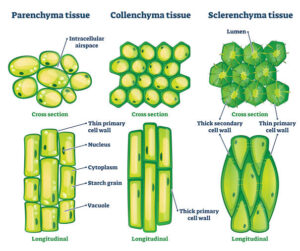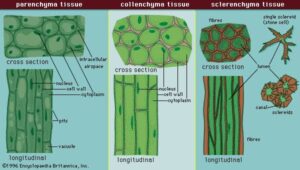Back to: Botany 300 Level
Hello, my smart friend! I hope you’re doing great today! Have you ever noticed how some plant parts are soft, while others are firm and strong? Think about a banana stem—it’s soft and easy to break. Now, compare it to a palm tree trunk, which is tough and rigid. Why do plants have these differences? The answer lies in specialised plant cells!
Specialized plant cells (sclerenchyma, parenchyma, collenchyma)
Just like our bodies have different types of cells—blood cells, muscle cells, and skin cells—plants also have different cell types, each with a special job. Today, we’ll talk about three important types: parenchyma, collenchyma, and sclerenchyma.
1. Parenchyma – The Jack of All Trades
Parenchyma cells are the most common and versatile cells in plants. They are found in almost every part—leaves, stems, roots, and fruits. These cells are thin-walled, soft, and flexible, just like the flesh of a tomato or a mango.

Functions of Parenchyma:
Food Production: In leaves, they contain chloroplasts and help in photosynthesis.
Storage: They store food, water, and nutrients, like in yam and cassava.
Healing and Repair: If a plant is injured, parenchyma cells help in healing and new growth.
Think of parenchyma like market traders in Nigeria—they do many different jobs, from selling food to repairing shoes. They are the all-purpose cells of a plant!
2. Collenchyma – The Flexible Support System
Collenchyma cells provide support and flexibility to plants. They have thicker cell walls than parenchyma, but they are still soft enough to bend. You can find them in young stems, leaves, and petioles (the stalk that connects a leaf to a stem).
Functions of Collenchyma:
Provides Strength and Flexibility: These cells help plants bend without breaking, like in pumpkin vines.
Supports Growing Parts: In young stems and leaves, collenchyma gives support before the plant becomes fully mature.
A good example of collenchyma in real life is the crunchy strands in celery or ugu (fluted pumpkin) stems. They help the plant stand strong but still allow movement. Imagine a strong but flexible cane—this is how collenchyma works in plants!
3. Sclerenchyma – The Tough Protector
Sclerenchyma cells are the strongest and most rigid plant cells. They have very thick walls made of lignin, a substance that makes them hard. Unlike parenchyma and collenchyma, these cells are usually dead when they are fully developed, but they still provide strength and support.

Functions of Sclerenchyma:
Provides Maximum Strength: These cells form the hard parts of plants, like coconut shells and palm tree trunks.
Protects Seeds and Nuts: The hard coats of seeds (like beans and maize) are made of sclerenchyma cells.
Supports Tall Plants: In big trees, sclerenchyma forms the tough wood that keeps the tree standing tall for many years.
Imagine a strong iron rod used in construction—sclerenchyma does the same job in plants, keeping them firm and unbreakable.
A Simple Story to Illustrate Specialised Plant Cells
Imagine a football team. The parenchyma players are like midfielders—they do a bit of everything: passing, attacking, and defending. The collenchyma players are like defenders—they give the team strength but still allow movement. The sclerenchyma players are like goalkeepers—they are firm and unshakable, protecting the goal. Just like every player has a role, every plant cell type has a specific job to keep the plant strong and healthy!
Summary
Plants have specialised cells that perform different functions:
Parenchyma cells are soft, flexible, and involved in food production, storage, and healing.
Collenchyma cells provide strength and flexibility, helping plants grow without breaking.
Sclerenchyma cells are tough and rigid, offering maximum support and protection.
Together, these cells ensure that plants grow properly, stand strong, and survive different environmental conditions.
Evaluation
- What are the three main types of specialised plant cells?
- Which plant cell type helps in food production and storage?
- Why are collenchyma cells important in young plants?
- What makes sclerenchyma different from the other two cell types?
- Give an example of a plant part where you can find sclerenchyma cells.
You’re doing an amazing job! You are becoming a real plant expert! Keep observing the plants around you—you’ll start to notice how these different cells help them grow. Stay curious, keep asking questions, and keep learning with Afrilearn. I can’t wait to see you in our next lesson—see you soon!
